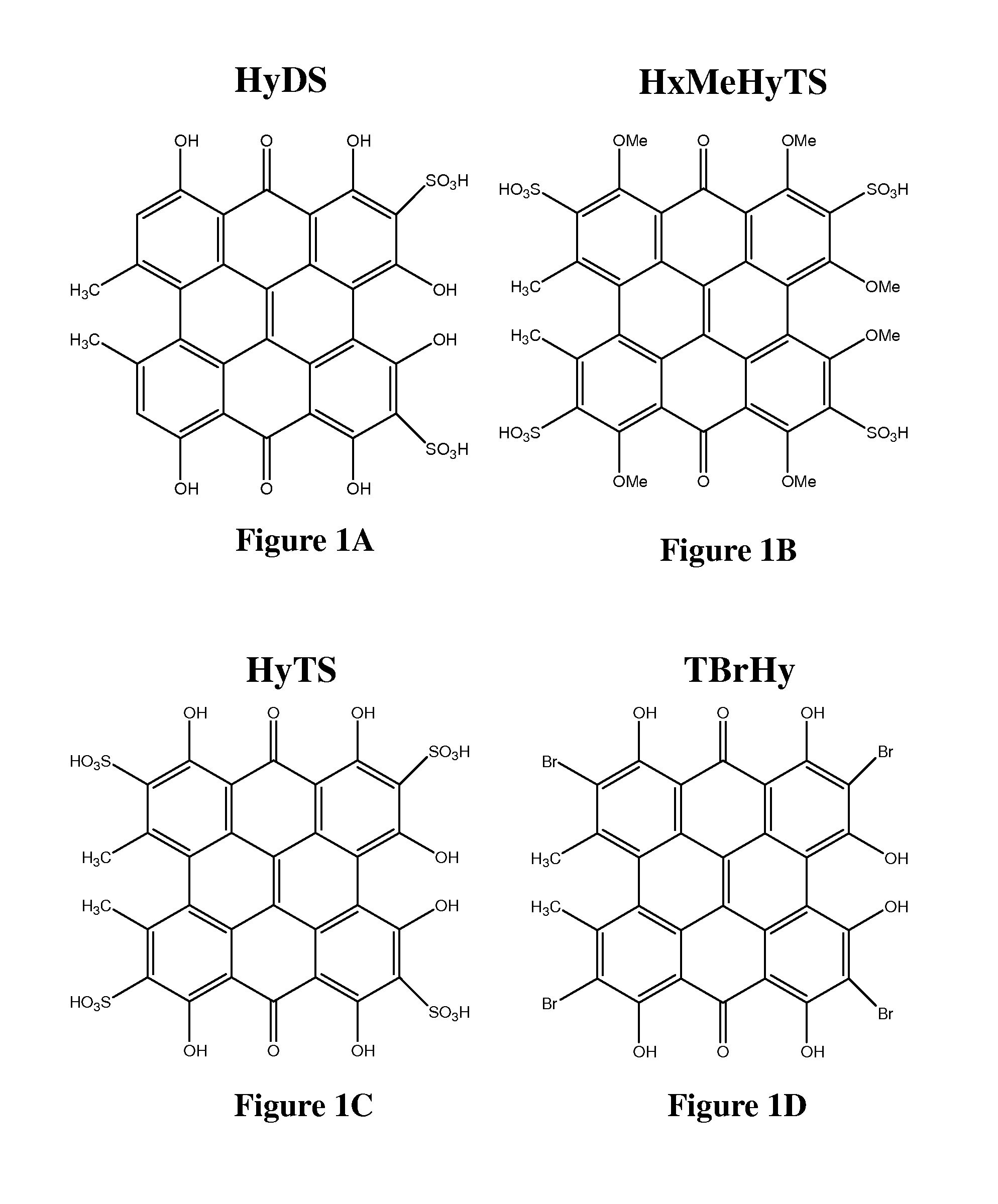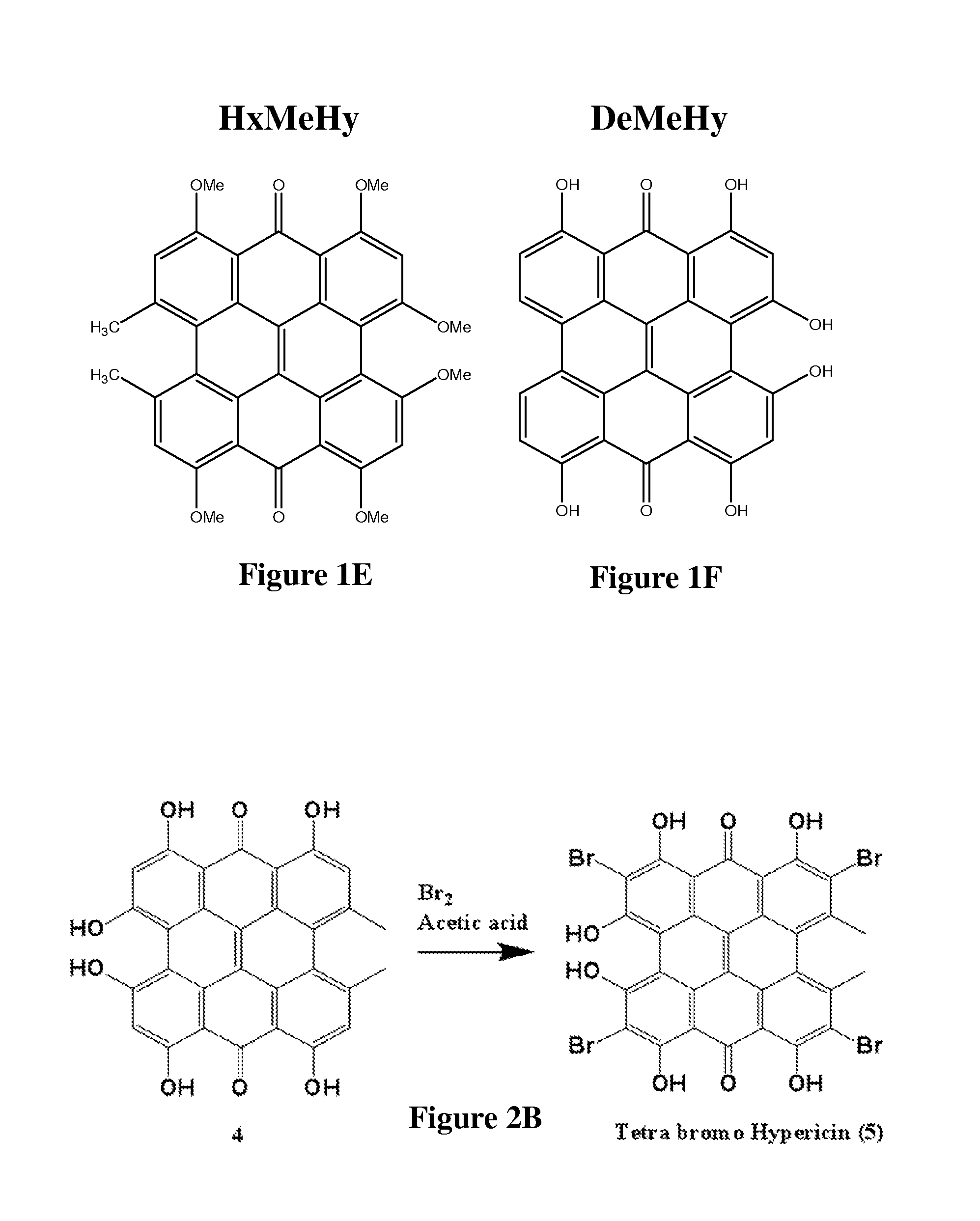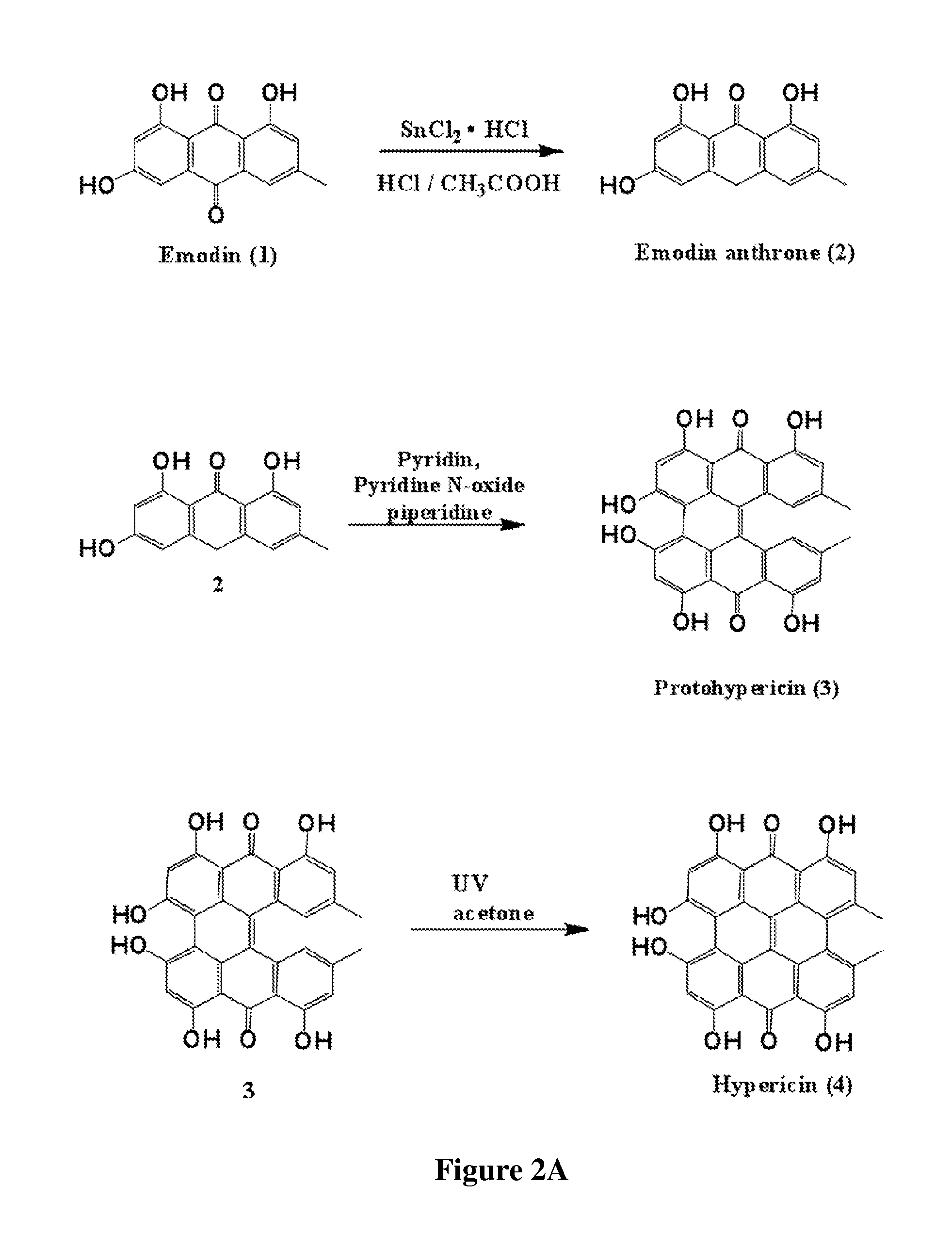Anthraquinones for use as radiosensitizers in cancer treatment
a radiosensitizer and anthraquinone technology, applied in the field of radiosensitizers, can solve the problems of cancer recurrence, cancer may frequently relapse or recur, and new challenges in cancer therapy have emerged. to achieve the effect of inhibiting the proliferation of cancer stem cells
- Summary
- Abstract
- Description
- Claims
- Application Information
AI Technical Summary
Benefits of technology
Problems solved by technology
Method used
Image
Examples
example 1
Synthesis of Hypericin Derivatives
[0140]The general procedure for the synthesis of hypericin and hypericin derivatives has been described [8, 9, 10]
[0141]The synthetic scheme for the preparation of hypericin is provided in FIG. 2A and includes:
[0142]Emodin anthrone (2): A warm solution of tin (II) chloride hydrate (41.41 gr, 0.185 mol) in conc. hydrochloric acid (213 mL) was added to a suspension of 1 (5 g, 0.0185 mol) in acetic acid (368 mL) to give the red-colour solution. The solution was refluxed for 24 hours and it was then poured into ice-water. The precipitate was collected by filtration to yield emodin anthrone (3.76 g, 80%).
[0143]1H-NMR (DMSO-d6, 200 MHZ δ) of compound 2: 2.32 (s, 3H, Me), 4.31 (s, 2H, CH2), 6.22 (d, 1H, J=2.35, H-4), 6.42 (d, 1H, J=2.35, H-2), 6.68 (s, 1H, H-5), 6.78 (s, 1H, H-7), 10.83 (s, 1H, OH), 12.22 (s, 1H, OH), 12.38 (s, 1H, OH) ppm.
[0144]Protohypericin (3): Compound 2 (1 gr, 3.9 mmol), FeSO4.7H2O (54 mg, 0.195 mmol), pyridine N-oxide (1.85 gr, 19.5...
example 2
Example 2A
Methods:
Cell Lines, Tumor Stem Cell, and Cell Culture
[0155]The following cell lines were originally obtained from the American Type Culture collection (ATTC):
[0156]Human breast carcinoma: MCF-7 (ATCC number: HTB-22); MDA-MB-231 (ATCC number: HTB-26)
[0157]Human glioma cell lines: Daoy (ATCC number: HTB-186) and
[0158]Rat glioma cell line: C6 (ATCC number: CCL107)
[0159]Human colorectal cancer cell line: HT-29 (ATCC number: HTB-38). All cells were cultured routinely in DMEM supplemented with 10% FCS.
[0160]To obtain tumor stem cells, cells were cultured in stem cell conditioned media. Briefly, breast and glioma cancer cells were cultured in serum-free DMEM media containing 10 n / ml bovine insulin, 100 μg / ml human transferrin, 100 μg / ml BSA, 60 ng / ml progesterone, 16 μg / ml putrescine, 40 μg / ml sodium selenite, 63 μg / ml N-acetylcysteine, 5 μM forskolin, 50 units / ml penicillin, and 50 μg / ml streptomycin, 10 ng / ml bFGF, and 10 ng / ml PDGF. In all experiments, cells were...
example 2b
Methods:
Cell Lines, Tumor Stem Cell, and Cell Culture
[0174]Linear cell (Lin) HT29 and MCF7 human breast carcinoma, were obtained from the American Type Culture Collection (ATCC).
[0175]Cells were cultured in Dulbecco's Modified Eagle Medium (DMEM), supplemented with 10% fetal calf serum (FCS) and antibiotics.
[0176]Enrichment of the cancer stem cells (CSCs) population was done by incubating linear cells in a DMEM / F-12 (HAM) 1:1 medium supplement with Insulin-Transferin-Soldium Selenite, and growth factors specific for each cell line. Cells considered enriched for CSCs after 10-15 days in CSCs medium.
Hypericin Derivatives and Doses
[0177]Three photosensitizing agents were used, Hypericin (Hy), Tetrabromo hypericin (TBrHy), and hypericin tetrasulfonic acid (HyTS) in the following concentrations: 0.1 μM, 1 μM and 2 μM. Drugs were protected from light for all time. Control cells were treated with 0.1% DMSO (vehicle).
[0178]Linear and CSC were exposed to 3 Gy irradiation daily for f...
PUM
 Login to View More
Login to View More Abstract
Description
Claims
Application Information
 Login to View More
Login to View More - R&D
- Intellectual Property
- Life Sciences
- Materials
- Tech Scout
- Unparalleled Data Quality
- Higher Quality Content
- 60% Fewer Hallucinations
Browse by: Latest US Patents, China's latest patents, Technical Efficacy Thesaurus, Application Domain, Technology Topic, Popular Technical Reports.
© 2025 PatSnap. All rights reserved.Legal|Privacy policy|Modern Slavery Act Transparency Statement|Sitemap|About US| Contact US: help@patsnap.com



